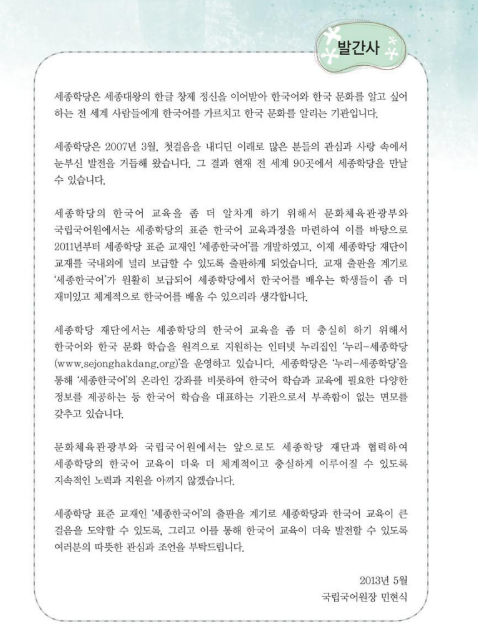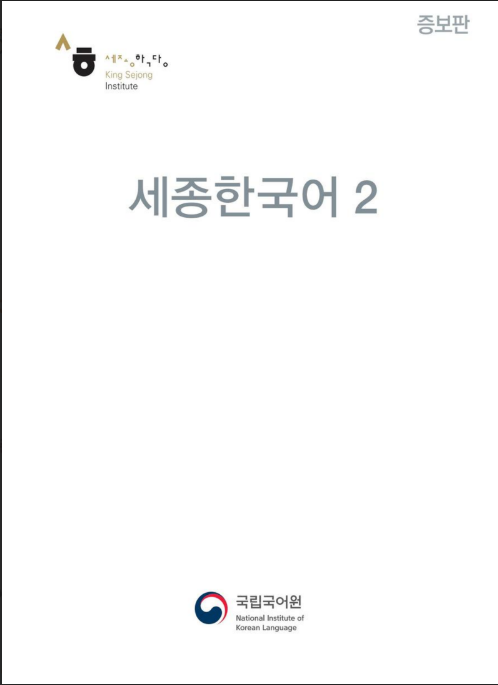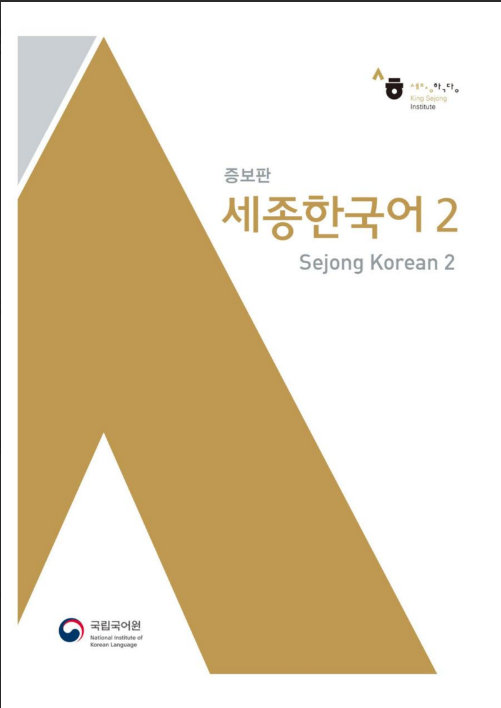


발간사
세종학당은 세종대왕의 한글 창제 정신을 이어받아 한국어와 한국 문화를 알리는 국제교류를 통해 한국어 교육의 확산과 발전을 이루고자 2007년 3월 설립되었습니다.
세종학당은 첫걸음을 내디딘 이래로 많은 분들의 관심과 사랑 속에서 눈부신 발전을 거듭해 왔습니다. 그 결과 현재 전 세계 90여 곳에서 세종학당을 만날 수 있습니다.
세종학당의 한국어 교육을 더욱 알차게 하기 위해 문화체육관광부와 국립국어원에서는 세종학당의 표준 한국어 교육과정을 마련하여 이를 바탕으로 2011년 부터 세종학당 표준 교재인 ‘세종한국어’를 개발하였고, 이제 세종학당 재단이 교재를 국내외에 널리 보급할 수 있도록 출판되었습니다. 교재 출판을 계기로 ‘세종한국어’가 원활히 보급되어 세종학당에서 한국어를 배우는 학생들이 좀 더 재미있고 체계적으로 한국어를 배울 수 있으리라 생각합니다.
세종학당 재단에서는 세종학당의 한국어 교육을 좀 더 충실히 하기 위해 인터넷 누리집 ‘누리-세종학당'(www.sejonghakdang.org)을 운영하고 있습니다. 세종학당은 ‘누리-세종학당’을 통해 ‘세종한국어’의 온라인 강좌를 비롯하여 한국어 학습과 교육에 필요한 다양한 정보를 제공하는 등 한국어 대표하는 기관으로서 부족함이 없는 면모를 갖추고 있습니다.
문화체육관광부와 국립국어원에서는 앞으로도 세종학당 재단과 협력하여 세종학당의 한국어 교육이 더욱 더 체계적이고 충실하게 이루어질 수 있도록 지속적인 노력과 지원을 아끼지 않을 것입니다. 이번 ‘세종한국어’의 발간이 세종학당과 한국어 교육의 발전에 밑거름이 되고 무엇보다도 여러분의 한국어 습득을 돕고 재미있게 배워 최종 과정까지 여러분의 삶이 더욱 아름답고 풍요롭게 꽃피기를 바라며 앞으로도 여러분들의 따뜻한 관심과 조언을 부탁드립니다.
2013년 12월
국립국어원장 민현식
차례
• 교재 구성표 …………………………………………….. 6
• 일러두기 ………………………………………………. 8
제 1 과 진로 ……………………………………………. 12
제 2 과 날씨와 계절 ………………………………………… 22
제 3 과 대중음악 ………………………………………….. 32
문화 1 한국인에게 인기 있는 직업 ……………………………… 42
제 4 과 길 묻기 ……………………………………………. 46
제 5 과 기념일 ……………………………………………. 56
제 6 과 쇼핑 ……………………………………………… 66
문화 2 한국의 선물 문화 …………………………………….. 76
제 7 과 여가 생활 ……………………………………………. 80
제 8 과 약속 ……………………………………………… 90
제 9 과 안부 ……………………………………………… 100
문화 3 상황별 존댓말과 반말의 사용 …………………………….. 110
제 10 과 명절 …………………………………………….. 114
제 11 과 부탁과 거절 ……………………………………….. 124
제 12 과 감정 …………………………………………….. 134
문화 4 한국인의 부탁과 거절 방식 ………………………………. 144
제 13 과 전자 제품 ………………………………………….. 148
제 14 과 소원 …………………………………………….. 158
문화 5 소원을 비는 한국인 ……………………………………. 168
• 듣기 대본 …………………………………………….. 173
• 정답 ………………………………………………… 183
• 문법 설명 …………………………………………….. 191
• 어휘 및 표현 색인 ………………………………………… 195
차례
Contents
• 교재 구성표 Table of Contents ……………………………. 6
• 일러두기 Introduction ………………………………….. 8
• 단원 구성 Unit Structure ……………………………….. 10
제 1 과 Unit 1 안부 Saying Hello …………………………… 12
제 2 과 Unit 2 취미 활동 Hobbies ……………………………. 22
제 3 과 Unit 3 음식 Food ………………………………….. 32
문화 1 Korean Culture 1 한국 음식 Korean Food ………………… 42
제 4 과 Unit 4 교통 Transportation …………………………… 44
제 5 과 Unit 5 길 찾기 Getting Directions ……………………… 54
제 6 과 Unit 6 전화 Phone Calls ……………………………… 64
문화 2 Korean Culture 2 한국의 대중교통 Public Transportation in Korea 74
제 7 과 Unit 7 외모 Appearance ………………………………. 76
제 8 과 Unit 8 가족 Family …………………………………. 86
제 9 과 Unit 9 여행 Travel …………………………………. 96
문화 3 Korean Culture 3 한국의 여행지 Korean Attractions in Korea … 106
제 10 과 Unit 10 건강 Health ……………………………….. 108
제 11 과 Unit 11 모임 Gatherings ……………………………… 118
제 12 과 Unit 12 고향 Hometowns …………………………….. 128
문화 4 Korean Culture 4 한국 사람들의 모임 Social and Family Gatherings in Korea 138
제 13 과 Unit 13 기분과 감정 Feelings and Emotions ………………. 140
제 14 과 Unit 14 미래 Future Plans ……………………………. 150
• 듣기 대본 Listening Scripts ………………………………. 161
• 정답 Answers …………………………………………. 169
• 문법 설명 Grammar Tips …………………………………. 177
• 어휘 및 표현 색인 Voca & Expressions ……………………… 181
교재 구성표
Table of Contents
| 단원 | 주제 | 기능 | 문법 | 어휘와 표현 |
| 1 | 안부 Saying Hello | 안부 묻기 Greetings, 안부와 근황에 대해 묻고 답하기 Talking About Greetings and Recent Events | -고, 그런데 | 안부 Greetings, 근황 Recent events |
| 2 | 취미 활동 Hobbies | 취미 이야기하기 Talking About Hobbies, 취미와 반도 이야기하기 How Often You Do Some Activities | -어서/아서/어서 | 취미 Hobbies, 반도 Frequency |
| 3 | 음식 Food | 음식 주문하기 Ordering Food, 맛 이야기하기 Talking About Taste | -(으)ㄹ래요, 무슨 맛 | 음식 Foods, 맛 Taste |
| 문화 1 Korean Culture 1 | 한국 음식 Korean Foods | 한국 음식 Korean Foods | ||
| 4 | 교통 Transportation | 교통수단에 대해 묻고 답하기 Talking About Different Modes of Transportation | -다가, -에서 … 까지 | 교통수단 이용 Using Different Modes of Transportation |
| 5 | 길 찾기 Getting Directions | 길 묻고 답하기 Talking About Directions | -(으)로, -아/어서/어서 | 방향 Directions, 이동 Movement |
| 6 | 전화 Phone Calls | 전화번호 묻고 답하기 Asking for Someone’s Phone Number and Giving Your Phone Number | -어/야 주다, -지요 | 전화 Phone Calls, 통화 표현 Useful Expressions for Phone Conversations |
| 문화 2 Korean Culture 2 | 한국의 대중교통 Public Transportation in Korea | 한국의 대중교통 Public Transportation in Korea | ||
| 7 | 외모 Appearance | 외모 묘사하기 Describing Appearance | -()으-, -고 있다 | 외모 Appearance, 옷차림 Dress |
| 8 | 가족 Family | 가족 소개하기 Introducing Family Members, 가족 소개하기 Talking About Your Family | -(으)세요, -(으)면 | 가족 Family, 가족 관계 Family Relationships |
| 9 | 여행 Travel | 여행 계획 세우기 Making Travel Plans, 여행 계획 세우기 Talking About Travel Plans | -겠-, -았/었을 때 | 여행 Travel, 여행 계획 Travel Plans |
| 문화 3 Korean Culture 3 | 한국의 여행지 Korean Attractions in Korea | 한국의 여행지 Korean Attractions in Korea | ||
| 10 | 건강 Health | 건강 상태 묻고 답하기 Asking and Talking About Health Conditions | -아/어 하다, -아/어서 | 건강 Health, 건강 상태 Health Status |
| 11 | 모임 Gatherings | 모임 약속하기 Making Plans for Gatherings, 모임 약속하기 Talking About Plans for Gatherings | -고 싶다, -았/었으면 좋겠다 | 모임 Gatherings, 약속 Plans |
| 12 | 고향 Hometowns | 고향 소개하기 Introducing Hometowns, 고향 소개하기 Talking About Your Hometown | -는데, -았/었다 | 고향 Hometowns, 고향 Hometowns |
| 문화 4 Korean Culture 4 | 한국 사람들의 모임 Social and Family Gatherings in Korea | 한국 사람들의 모임 Social and Family Gatherings in Korea | ||
| 13 | 기분과 감정 Feelings and Emotions | 기분과 감정 표현하기, 기분과 감정 표현하기 Talking About Feelings and Emotions | -아/어 보이다, -게 | 기분 Feelings, 감정 Emotions |
| 14 | 미래 Future Plans | 미래 계획 말하기, 미래 계획 말하기 Talking About Future Plans | -(으)ㄹ 것이 다, -려고 하다 | 미래 Future Plans, 계획 Plans |
일러두기
Introduction
Sejong Korean 2 has been developed to help Korean language learners studying at King Sejong Institute to improve their communication skills in Korean and deepen their understanding of Korean culture.
Development Direction of Sejong Korean 2
- This textbook aims to encourage Korean language learners to understand different cultures and improve their linguistic and cultural competence which will help them communicate with people from other cultures. This perspective is driven by King Sejong Institute’s mission statement.
- The goal of this textbook is to meet the Level 1 requirements of the Standardized International Model for Korean Language Education. Korean language learners who have successfully achieved the learning objectives of this textbook will be able to communicate in Korean about common topics frequently addressed in daily contexts and public places.
- The characters and situations presented in the textbook are designed to represent a variety of regions with different socio-cultural backgrounds, reflecting the locations of several King Sejong Institute branches and the learning environments of overseas beginning Korean language learners.
- This textbook provides various practical assignments designed to improve the speaking, listening, reading and writing skills of Korean language learners.
- The communication activities presented in the textbook are combined with linguistic components to simultaneously improve Korean language learners’ fluency and accuracy.
- The learning contents and activities are designed to help adult Korean language learners to effectively follow the course based on their individual cognitive abilities and learning strategies.
- The intercultural approach of this textbook provides Korean language learners with a chance to learn about the daily lives of Koreans in comparison to the learners’ own lives. While comparing the practical examples of Korean culture with their own cultures, Korean language learners can come to easily understand Korean society and culture.


